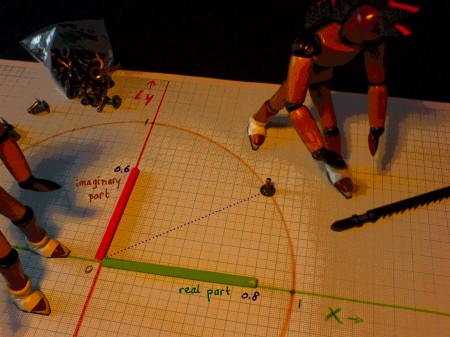
intro
Since Fast Fourier Transform works by virtue of complex
multiplication,
complex signals could be transformed. In audio dsp, signals are
often real only. One FFT input remains unemployed, while you can not do
away with the imaginary part to reduce the count of operations. But you
can 'abuse' the imaginary input and feed a second real signal in it.
Since two arbitrary real signals are not orthogonal, like a complex
signal is, the output spectrum is a mix which has to be split somehow.
Let me first illustrate the difference between a complex signal and
a real signal. A complex signal, consisting of two orthogonal phases,
has a distinct rotational direction. The spectrum of a complex sinusoid
would have one real part and one imaginary part. A complex number, say
(a+bi). Here is an example:
 |
Real signals, consisting of a single phase, have no explicit
rotational direction, or you could say they rotate in both positive and
negative direction. Therefore, a real sinusoid correlates with two real
parts and two imaginary parts.
 |
The imaginary parts in a real signal are imaginary indeed, therefore
they always add up to zero. The real parts come in a pair with equal
value and equal sign, each representing half of the correlation. The
spectrum of a real sinusoid has the form:
0.5(a+bi) + 0.5(a-bi)
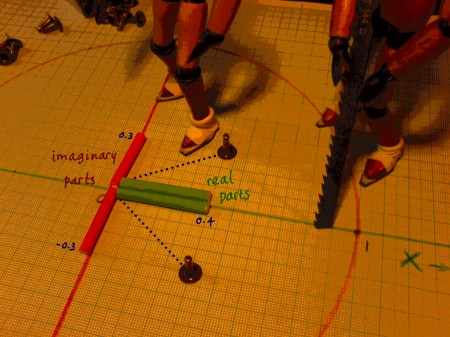 |
If you would now feed that same real sinusoid in the imaginary FFT
input, the correlation coefficients will simply shift by pi/2 radians.
The sinusoid spectrum is then identified:
0.5i(c+di) + 0.5i(c-di) = 0.5(ci-d) + 0.5(ci+d)
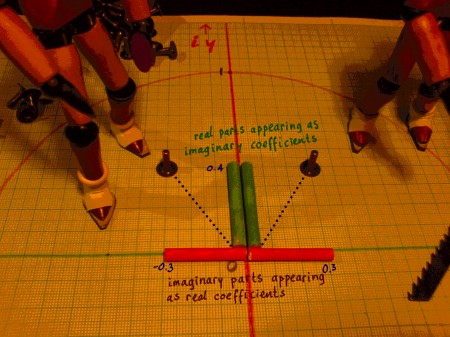 |
The picture below shows the merged spectra as a... stack of mikado
sticks. They represent:
0.5(a+a-d+d) + 0.5(ci+ci+bi-bi)
This can be distinguished as coefficients found below and above
Nyquist:
below Nyquist 0.5(a-d) + 0.5(c+b)i
above Nyquist 0.5(a+d) + 0.5(c-b)i
From these we can extract a, b, c and d:
a = 0.5(a-d) + 0.5(a+d) (real below Nyquist + real
above Nyquist)
b = 0.5(c+b)i - 0.5(c-b)i (im. below Nyquist - im. above Nyquist)
c = 0.5(c+b)i + 0.5(c-b)i (im. below Nyquist + im. above Nyquist)
d = 0.5(a+d) - 0.5(a-d) (real above Nyquist - real
below Nyquist)
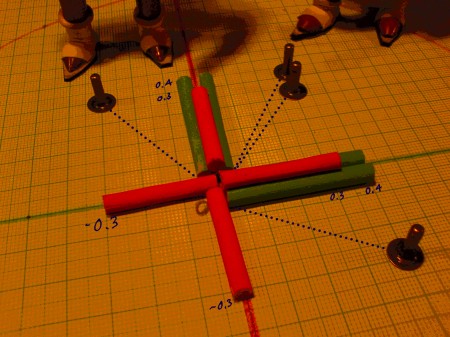 |
The values of a, b, c and d represent coefficients for the positive
frequencies in (a+bi) and (c+di). From them, we can compute their
conjugates. These follow the normal principle
of real coefficients having equal value and sign, where imaginary parts
have equal value and opposite sign. Two index points have no
conjugates: harmonic zero (DC) and harmonic N/2, the Nyquist point.
Since the Nyquist point is midway between the positive and negative
frequencies, it can be computed within the routine for the positive and
negative frequencies. The index is then N/2 for both positive and
negative. But DC has to be computed separately, because point N does
not exist. Below is how you could do such a thing in C code. For
simplicity, I do not multiply with 0.5, because this can also be
compensated for in a regular normalisation of forward transform.
// split sum spectrum real/im into real/im1 and real/im2 void splitspectra(double *real, double *im, double *real1, double *im1, double *real2, double *im2, unsigned int N) { unsigned int n; real1[0] = real[0] + real[0]; real2[0] = im[0] + im[0]; im1[0] = im2[0] = 0.; for(n=N>>1; n; n--) // include Nyquist frequency bin { real1[n] = real[n] + real[N-n]; real1[N-n] = real1[n]; im1[n] = im[n] - im[N-n]; im1[N-n] = -im[n]; real2[n] = im[n] + im[N-n]; real2[N-n] = real2[n]; im2[n] = real[N-n] - real[n]; im2[N-n] = -im[n]; } } |
Below is an example of two merged spectra that we are going to
split.
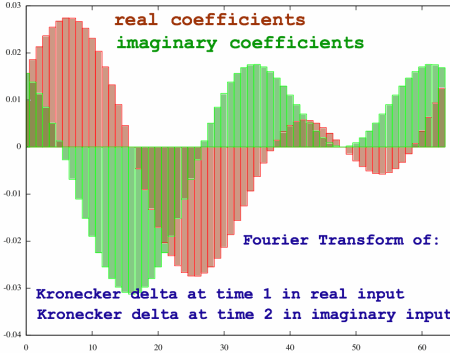 |
Splitting the spectra with the code described above, two familiar
patterns arise:
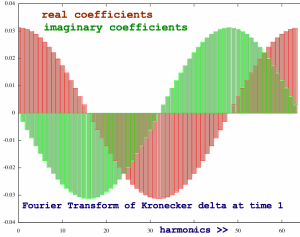 |
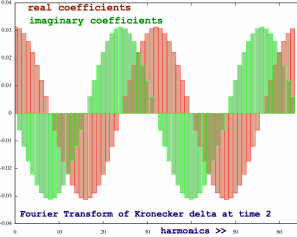 |
Apparently I forgot to modify the normalisation, and indeed the
coefficients have twice the normal weight. Anyway, all theory is
confirmed by this result.
For inverse FFT, we have to merge the two spectra into one spectrum
which is transformed by an inverse complex FFT. The signals appear at
the real and imaginary FFT outputs. Merging the spectra is simply the
inverse process of splitting: reverse the equations. It took me quite
some time to get it right, but the operations are very simple again.
// merge spectra real/im1 and real/im2 into real/im void mergespectra(double *real, double *im, double *real1, double *im1, double *real2, double *im2, unsigned int N) { unsigned int n; im1[0] = real2[0]; for(n=N>>1; n; n--) // start at Nyquist frequency { real[n] = real1[n] + im2[N-n]; real[N-n] = real1[N-n] + im2[n]; im[n] = real2[n] + im1[n]; im[N-n] = im1[N-n] + real2[N-n]; } } |
To compensate the doubling of the correlation magnitude, I have
adapted the 'normalisation' factor in my forward FFT. Normally I have
this factor at 1./N and now it is set to 0.5/N. This arrangement saves
quite some multiplications, but you must not forget to include the
Nyquist point in the computations of split and merge. This coefficient
will only get the correct value when it is treated like the other
points. In the inverse transform, no further normalisation factor is
needed. The signals are reconstructed with their
original samplevalues.
Obviously, the procedure for splitting and merging can be further
optimized. For example, computations could be done partly in place,
using two
real and imaginary arrays instead of three. But I will skip all that,
since feeding two real signals in one complex FFT is not the final
goal.
The whole purpose of this page was to introduce the topic of real FFT
at a slow pace. The next step is much more complicated: how to cut a
real signal in two parts and process it with a complex FFT of length
N/2. That is for the next page.